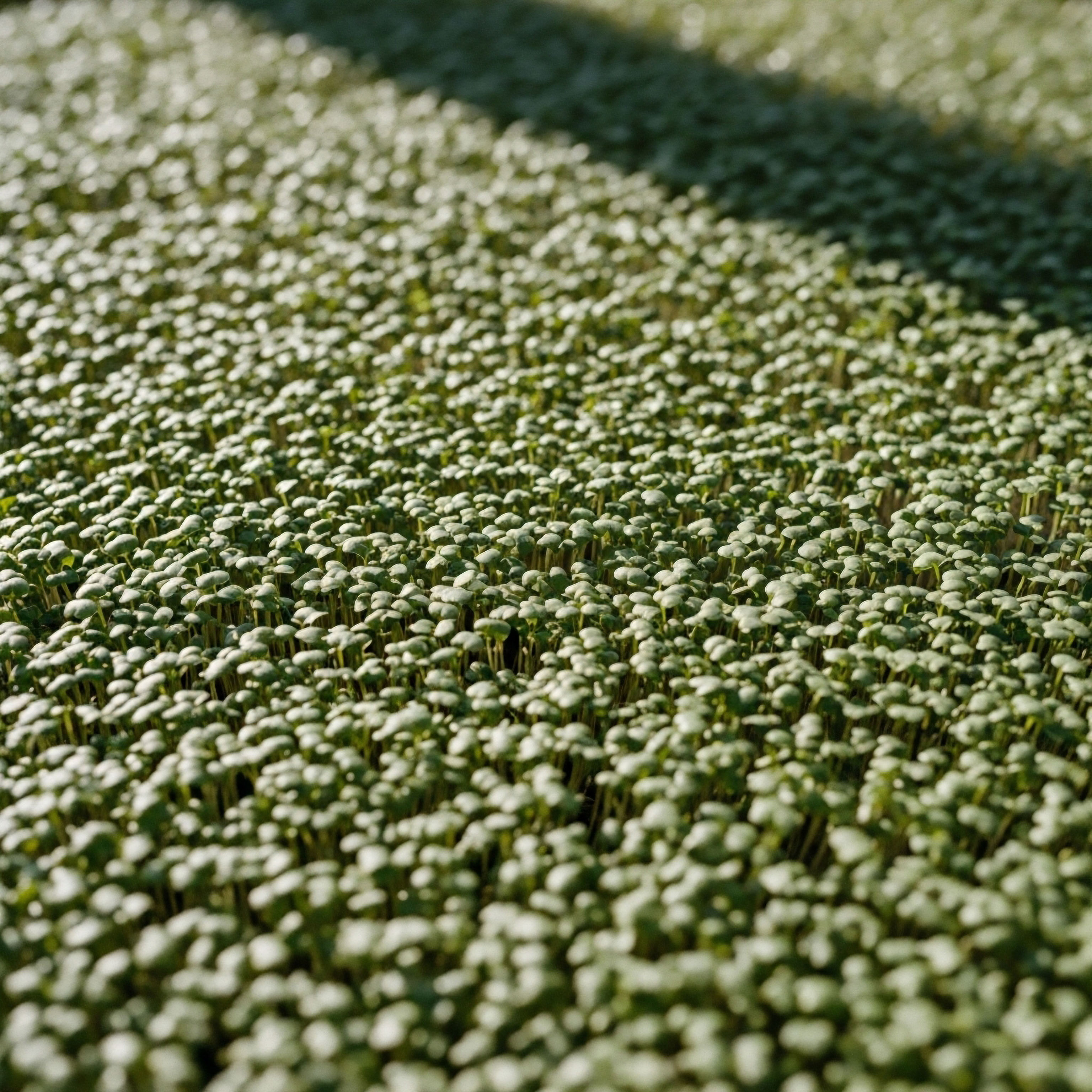

Fundamentals
To witness changes in your hair ∞ thinning where there was once fullness ∞ is to experience a tangible shift in your own biology. This process often feels disempowering, a quiet concern that grows louder with each passing day. The experience is valid, rooted in a complex interplay of signals deep within the skin.
Your journey toward understanding begins with recognizing that the hair follicle is not a simple structure; it is a dynamic, self-renewing mini-organ, a complex biological system operating under the precise control of your body’s internal messaging service. At the heart of this system are hair follicle stem cells, the resident architects responsible for rebuilding the follicle and producing new hair. Their activity, however, is entirely dependent on the instructions they receive.
Peptides are the language of these instructions. These short chains of amino acids are the body’s native communicators, signaling molecules that carry messages between cells, directing processes from healing to growth. When we speak of peptides in the context of hair health, we are discussing a method of re-establishing clear communication with the stem cells that govern hair production.
By delivering specific, targeted messages, peptides can influence the behavior of these stem cells, awakening them from dormancy and providing the necessary directives to initiate and sustain growth. This approach is about working with your body’s existing framework, using its own language to restore a biological process that has been disrupted.

The Life Cycle of a Hair Follicle
Understanding how peptides work requires a foundational knowledge of the hair follicle’s life cycle. This process is a continuous, elegant loop of growth, transition, and rest. Each follicle on your scalp operates on its own timeline, ensuring a constant state of renewal. The cycle is composed of distinct phases, each governed by a unique set of biochemical signals. Disruptions to this cycle, often driven by hormonal shifts, inflammation, or nutrient deficiencies, are at the core of most hair loss conditions.
- Anagen Phase This is the active growth phase. During this period, which can last for several years, hair follicle stem cells are highly active, dermal papilla cells signal for rapid cell division, and the hair shaft is constructed and elongated. Peptides that support this phase aim to prolong its duration, resulting in longer, healthier hair.
- Catagen Phase A brief, transitional phase lasting only a few weeks. During this time, the hair follicle shrinks, detaches from its blood supply, and cell division ceases. This is a controlled, programmed regression that prepares the follicle for a period of rest.
- Telogen Phase This is the resting phase, which can last for several months. The hair shaft is dormant and remains in the follicle, but it is no longer growing. At the end of this phase, the old hair is shed to make way for a new anagen hair to begin its cycle. An increase in the number of follicles prematurely entering the telogen phase leads to noticeable thinning.
The transition from the resting telogen phase back to the active anagen phase is a moment of critical biological communication. It is here that hair follicle stem cells must be activated. Peptides can act as the catalyst for this reawakening, signaling the stem cells to begin the process of rebuilding and regeneration, thereby initiating a new growth cycle.
This intervention is about restoring balance to the cycle, encouraging more follicles to remain in the anagen phase and prompting dormant follicles to re-engage in active growth.


Intermediate
Moving beyond the fundamentals, we can begin to appreciate the specific mechanisms through which peptides exert their influence on the hair follicle microenvironment. The interaction is a sophisticated dialogue. Peptides function as highly specific keys, designed to fit into the molecular locks, or receptors, on the surface of target cells, including hair follicle stem cells and the surrounding dermal papilla cells.
When a peptide binds to its receptor, it initiates a cascade of signals inside the cell, a chain of command that ultimately alters cellular behavior. This can mean upregulating the production of essential growth factors, stimulating blood vessel formation to nourish the follicle, or strengthening the structural proteins that anchor the hair in place.
Peptides function as precise biochemical messengers that can reactivate and sustain the follicle’s growth cycle.
The goal of peptide therapy in a clinical context is to introduce specific peptides that can amplify the body’s natural regenerative signals. For instance, some peptides are known to stimulate angiogenesis, the formation of new blood vessels. Improved microcirculation in the scalp ensures a richer supply of oxygen and nutrients to the hair follicle, creating a more robust environment for sustained growth.
Others work by boosting the synthesis of collagen and other components of the extracellular matrix, the structural scaffolding that supports the follicle. A stronger matrix means better hair anchoring and reduced shedding. This is a multi-pronged approach, addressing not just the stem cells themselves but the entire ecosystem that supports their function.

Key Peptides and Their Mechanisms
Different peptides have distinct roles based on their amino acid sequence and structure. This specificity allows for a targeted approach to addressing the various factors that contribute to hair thinning. While research is ongoing, several peptides have been identified for their significant potential in modulating the hair growth cycle. The following table outlines some of the key players and their primary modes of action, providing a clearer picture of how these molecules function at a biological level.
| Peptide Class | Primary Mechanism of Action | Targeted Biological Outcome |
|---|---|---|
| Copper Peptides (e.g. GHK-Cu) | Stimulates angiogenesis, reduces inflammation, and modulates gene expression for growth factors. | Improved scalp microcirculation and a healthier follicular environment. |
| Biomimetic Peptides (e.g. Acetyl Tetrapeptide-3) | Strengthens the extracellular matrix around the follicle, improving hair anchoring. | Reduced hair shedding and improved hair density. |
| Growth Hormone Secretagogues (e.g. Sermorelin, Ipamorelin) | Increases systemic levels of Insulin-like Growth Factor 1 (IGF-1), a key regulator of the anagen phase. | Prolonged anagen (growth) phase and stimulation of follicular activity. |
| Body Protective Compounds (e.g. BPC-157) | Promotes healing and regeneration by stimulating the production of growth factors and new blood vessels. | Activation of dormant hair follicles and reduced scalp inflammation. |

What Is a Peptide Protocol for Hair Health?
A therapeutic protocol utilizing peptides for hair restoration is designed to deliver these signaling molecules in a manner that maximizes their effect on the scalp’s cellular environment. This is a systematic process that requires consistency and a clear understanding of the objectives. While specific protocols are always personalized, they generally follow a logical progression aimed at stimulating and supporting the hair follicle’s return to a healthy growth cycle.
- Initial Consultation and Assessment The first step involves a thorough evaluation of the individual’s hair loss pattern, medical history, and overall health. This allows for the selection of the most appropriate peptide or combination of peptides to address the underlying causes of hair thinning.
- Targeted Delivery Peptides can be administered through various methods. Topical solutions are common, allowing for direct application to the scalp. For more systemic effects or deeper penetration, subcutaneous injections may be utilized, delivering the peptides into the bloodstream to influence growth factors throughout the body.
- Consistent Application The protocol will specify the frequency and dosage of application. Consistency is vital, as the goal is to maintain a steady presence of these signaling molecules to continuously encourage the follicles to remain in the anagen phase and to awaken dormant ones.
- Monitoring and Adjustment Progress is monitored over several months. The biological processes of hair growth are slow and methodical. Adjustments to the protocol may be made based on the observed response, ensuring the approach remains optimized for the individual’s unique physiology.


Academic
At the most granular level, the interaction between peptides and hair follicle stem cells (HFSCs) is a matter of molecular signaling within a highly specialized microenvironment known as the stem cell niche.
This niche, located in a region of the outer root sheath called the bulge, is a complex ecosystem where HFSCs are maintained in a state of quiescence, awaiting the precise signals that will trigger their activation and differentiation.
The transition from the telogen (resting) to the anagen (growth) phase of the hair cycle is entirely dependent on the successful orchestration of signaling cascades between the HFSCs and the nearby dermal papilla cells (DPCs). This crosstalk is the central event in hair regeneration, and it is here that peptides find their therapeutic window.
The activation of HFSCs is governed by a delicate balance between activating and inhibitory signals. Two of the most critical pathways are the Wnt/β-catenin pathway, which is a primary driver of anagen initiation, and the Bone Morphogenetic Protein (BMP) signaling pathway, which promotes quiescence and maintains the telogen state.
Peptides can directly or indirectly modulate these pathways. For instance, certain peptides can upregulate the expression of Wnt proteins or downregulate BMP inhibitors, effectively tilting the balance in favor of activation. This shifts the HFSCs from their dormant state into a proliferative mode, leading to the formation of a new hair matrix and the initiation of the anagen phase.

How Do Peptides Influence Key Signaling Pathways?
The influence of peptides extends beyond a simple on/off switch for stem cells. They are modulators of a complex network of growth factors and cytokines that fine-tune the processes of cell proliferation, differentiation, and survival within the follicle.
For example, the peptide GHK-Cu has been shown to stimulate the expression of Vascular Endothelial Growth Factor (VEGF), a potent angiogenic factor that improves blood supply to the follicle. An enhanced vascular network is critical for meeting the high metabolic demands of the anagen phase.
Similarly, peptides can influence the production of Keratinocyte Growth Factor (KGF) and Insulin-like Growth Factor 1 (IGF-1), both of which are essential for maintaining the proliferative activity of the hair matrix cells that build the hair shaft.
The sophisticated interplay between peptides and cellular signaling pathways dictates the follicle’s transition from dormancy to active regeneration.
A recent study on AIMP1 (aminoacyl-tRNA synthetase-interacting multifunctional protein 1) revealed that a specific fragment of this protein, secreted by HFSCs themselves, acts as a potent activator of DPCs. This finding underscores the paracrine signaling loop that maintains follicular homeostasis.
The study identified a 41-amino-acid peptide fragment (TN41) that could promote the telogen-to-anagen transition without inducing an inflammatory response. This illustrates the immense specificity possible with peptide-based interventions. By identifying and synthesizing the precise amino acid sequences that activate key cellular players like the DPCs, it becomes possible to directly support the signaling environment required for robust hair growth.
| Signaling Pathway | Role in Hair Cycle | Potential Point of Peptide Modulation |
|---|---|---|
| Wnt/β-catenin | Primary initiator of the anagen phase; promotes HFSC activation and proliferation. | Upregulation of Wnt ligands or inhibition of pathway antagonists like Dkk1. |
| BMP Signaling | Maintains HFSC quiescence and promotes the telogen phase. | Downregulation of BMP proteins (e.g. BMP4) or upregulation of BMP inhibitors like Noggin. |
| VEGF Signaling | Promotes angiogenesis, ensuring adequate nutrient and oxygen supply to the follicle. | Stimulation of VEGF expression in dermal papilla cells. |
| IGF-1 Signaling | Prolongs the anagen phase and supports the metabolic activity of matrix cells. | Systemic increase via growth hormone secretagogues or local upregulation. |

The Role of Extracellular Matrix Remodeling
The structural integrity of the hair follicle and its connection to the surrounding tissue are maintained by the extracellular matrix (ECM), a complex network of proteins like collagen and laminin. The cyclical growth and regression of the hair follicle require constant remodeling of this matrix.
Certain peptides, particularly copper peptides, play a significant role in this process. They stimulate the synthesis of ECM components while also upregulating enzymes responsible for breaking down old, damaged matrix proteins. This dual action ensures a healthy, functional ECM that can properly anchor the hair follicle, a process vital for preventing premature shedding.
Effective peptide therapy supports both the cellular signaling and the structural scaffolding required for healthy hair growth.
This remodeling capability is also linked to the anti-inflammatory properties of some peptides. Chronic micro-inflammation in the scalp is a known contributor to hair loss, as inflammatory cytokines can disrupt the hair growth cycle and damage follicular structures.
By modulating the inflammatory response and promoting a regenerative ECM environment, peptides help create the optimal physiological conditions for HFSCs to activate and for the anagen phase to be sustained. This systems-based approach, which addresses both the signaling environment and the physical microenvironment, is what gives peptide therapy its profound potential.
- Key Growth Factors Peptides can influence a range of growth factors essential for follicular health.
- Vascular Endothelial Growth Factor (VEGF) Critical for blood vessel formation.
- Keratinocyte Growth Factor (KGF/FGF7) Stimulates the proliferation of the matrix cells that form the hair shaft.
- Insulin-like Growth Factor 1 (IGF-1) Helps to maintain the anagen phase and regulate cell survival.
- Hepatocyte Growth Factor (HGF) Involved in the regulation of the hair growth cycle.

References
- Paus, R. & Cotsarelis, G. (1999). The biology of hair follicles. New England Journal of Medicine, 341(7), 491-497.
- Hsieh, M. J. Lee, C. H. Chen, Y. J. & Pang, J. S. (2017). Pentadecapeptide BPC 157 enhances angiogenesis in hindlimb ischemia in rats. Journal of Orthopaedic Surgery and Research, 12(1), 1-8.
- Pickart, L. & Margolina, A. (2018). Regenerative and protective actions of the GHK-Cu peptide in the light of the new data. International journal of molecular sciences, 19(7), 1987.
- Philp, D. Nguyen, M. Scheremeta, B. St-Surin, S. Villa, A. M. Orlicky, D. & Kleinman, H. K. (2004). Thymosin β4 increases hair growth by activation of hair follicle stem cells. The FASEB journal, 18(2), 385-387.
- Jo, S. Y. Kim, E. Kim, J. Kim, H. Park, J. W. Lee, S. J. & Kim, S. (2020). AIMP1-derived peptide secreted from hair follicle stem cells promotes hair growth by activating dermal papilla cells. Cell reports, 33(10), 108473.

Reflection
The information presented here offers a map of the biological territory, detailing the cellular conversations that dictate the life of a hair follicle. This knowledge serves as a powerful tool, shifting the perspective from one of passive concern to one of active understanding.
Your body operates on a system of intricate signals, a language of precision and intent. Learning this language is the first step in providing your system with the resources it needs to function optimally. The path forward is one of personalized exploration, a journey to understand your own unique biological narrative and how to best support it. The potential for regeneration lies within your own cellular architecture, waiting for the right message to begin its work.



